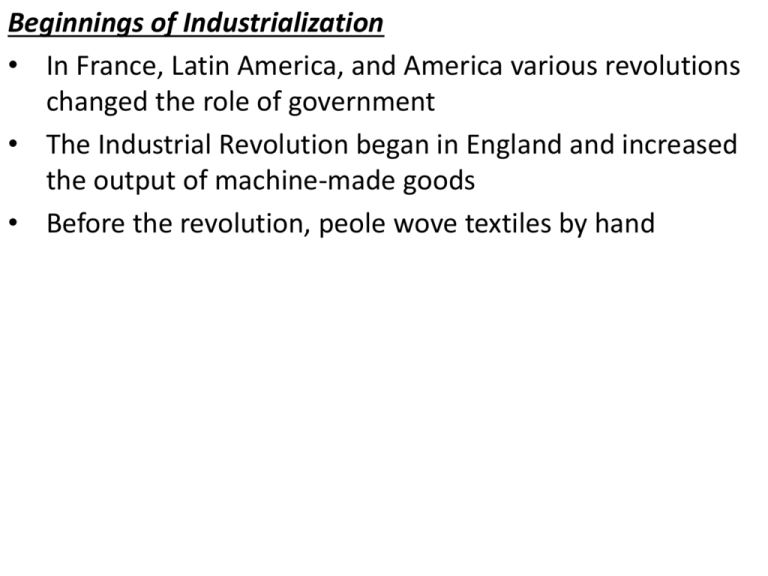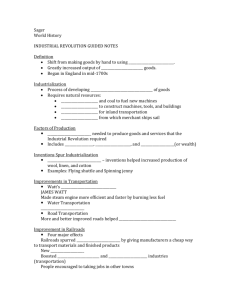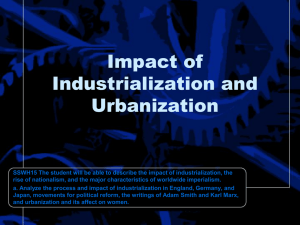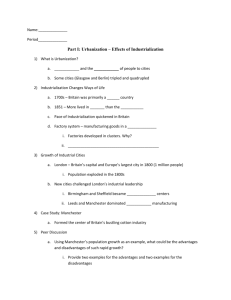Industrialization
advertisement

Beginnings of Industrialization • In France, Latin America, and America various revolutions changed the role of government • The Industrial Revolution began in England and increased the output of machine-made goods • Before the revolution, peole wove textiles by hand Industrial Revolution Begins in Europe • In the 1700’s, farmers began buying up the land once worked by village farmers • They improved farming methods, and started an agricultural revolution Agricultural Revolution Paves the Way • As farmers bought land, they made enclosures, which had two important results landowners tried new agricultural methods and landowners forced small farmers to become tenant farmers • In 1701, Jethro Tull invented the seed drill which helped more seeds take root Rotating Crops • Crop rotation improved the three-field system by switching the type of crop that was planted from year to year • Livestock breeders increased their methods too Robert Bakewell only allowed his best sheep to breed • With more food from increased agriculture, there was a growing demand for food and goods such as cloth • As village farmers lost their land, they had two choices become tenant farmers or move to the cities and work in factories Why the Industrial Revolution Began in England • England had expensive natural resources, which industrialization requires. These resources included: water power and coal to fuel the new machines, iron ore to construct machines, tools, and buildings, rivers for inland transportation, harbors from which merchant ships set sail • In addition to resources, Britain had an expanding economy • The highly developed banking system led people to make investments in machinery • Other countries had some, but Britain had ALL the factors of production (land, labor, and capital) Inventions Spur Industrialization • The textile industry was the first to be innovated Changes in the Textile Industry • In 1733 John Kay invented the flying shuttle, which doubled the work of a weaver in a day • In 1764 James Hargreaves invented the spinning jenny, which allowed one spinner to weave eight threads at a time • In 1769, Richard Arkwright invented the water frame, which used waterpower from streams to drive the spinning wheels • In 1779 Samuel Crompton combined the spinning jenny and the water frame to produce the spinning mule • In 1787 Edmund Cartwright invented the power loom • These inventions were expensive, and made the use of these machines limited to the most wealthy • Most of these machines were used in factories, which relied on running water and were often near rivers/streams • England’s cotton came from the Americas, and was particularly difficult to remove the seeds • In 1793 Eli Whitney invented the cotton gin, increasing cotton production almost 80% in 20 years Improvements in Transportation • As early as 1705, coal workers were using steam powered pumps to remove water from mine shafts. It worked, but used a great amount of fuel Watt’s Steam Engine • In 1774 Watt joined with Matthew Boulton and devised a better machine that used less fuel Water Transportation • Steam could propel boats, and Robert Fulton bought a boat from Watt and Boulton • In 1805, Fulton’s Clermont was used to ferry passengers along the Hudson River • In England, 4250 miles of inland channels made the transportation of goods much easier Road Transportation • In the 1800’s, John McAdam created “macadam” roads • Private investors created roads and charged tolls to cross them “turnpikes” The Railway Age Begins • Steam engine on wheels – the railroad locomotive – drove industrialization in England after 1820 Steam-Driven Locomotives • George Stephenson built around 20 engines for mine operators • In 1821, he began construction on the first railroad line Liverpool-Manchester Railroad • In 1829, trials were held to choose the best locomotive for use on the new line • Rocket hauled a 13 ton load twenty four miles per hour • The Liverpool-Manchester Railway opened in 1830 Railroads Revolutionize Life in Britain • The locomotive had at least 4 effects: – Railroads spurred industrial growth by provided cheap transportation of goods – The new industry created hundreds of thousands of jobs for miners and railroad workers. The miners provided iron for the tracks and coal for the steam engine – The railroads boosted England’s fishing and agricultural industries – Finally, railroads encouraged country people to take distant city jobs Industrialization: Manchester • While in the long run industrialization improved the quality of life for most people living in Great Britain, initially it caused human suffering • Industrialization brought unhealthy working conditions, air and water pollution, and child labor; it also led to increased tensions between working and middle class Industrialization Challenges Life Industrial Cities Rise • By the 19th century, a shift began where ppl moved from the rural areas to the cities due to wealthy landowners buying up the farmland • A period of urbanization occurred, and the number of cities hosting 100,000+ rose from 22 to 47 from 1800-1850 • Cities such as Manchester, London, Birmingham, Sheffield, and Paris were among Europe’s largest Living Conditions • Because cities grew so rapidly, there were no development plans (sanitation or building codes) • As cities grew, there was inadequate housing, education, and police protection • Streets had no drains and garbage collected; workers lived in cramped settings and cholera spread throughout the cities • Average life span was 17 years old, compared to 38 in more rural areas Working Conditions • Average worker spent 14 hours a day at work for 6 days a week • Work was routinized unlike farm labor • Factories were seldom well lit of clean machines injured workers • Coal mines were the worst places to work; most mine employees lived on average 10 years shorter than everyone else Class Tensions Grow • While life for workers was rough, the Industrial Revolution brought enormous wealth to the merchant class led to an increase in split between working and middle class The Middle Class • Made up of factory owners, shippers, and merchants • These people enjoyed a comfortable standard of living • Many were now wealthier than the landowning aristocracy The Working Class • Between 1800-1850 many laborers saw their livelihoods disappear as machines took their jobs • Some of these workers smashes new machines in frustration Ned Ludd and the weaving machine in 1779 England Positive Effects of the Industrial Revolution • Despite the problems, it had some positive effects • Created jobs, fostered technological progress and innovation, and most importantly created hope • In the long run, it created better diets, better housing, and cheaper, manufactured goods Long Term Effects • Profits from industrialization led to tax revenue, which was used to invest in urban improvements in cities • Goods considered luxury 50 years ago are commodities today The Mills of Manchester • Manchester already had access to waterpower, and had available labor from Liverpool • Manchester displayed not only the upside to industrialization but also the detriment • To maximize profits, workers labored under bad conditions in Manchester • Children worked as early as 6, and for thirteen hours a day • Half an hour for lunch and an hour for dinner; beat the children to keep them awake and working • British government passed first Factory Ac tin 1819, which restricted the working age and hours • The coal used in factories blackened the air in Manchester, textile dies colored the rivers • While industrialization had many positive effects on society, as seen in Manchester’s case study it was just as detrimental to the environment and to workers Industrialization Spreads Industrial Development in the United States • During the War of 1812, Britain’s blockade of US ports forced the US to begin producing its own goods and rely less on imports Industrialization in the US • Began in the textile industry in 1789 when Sam Slater emigrated to the US and built a spinning machine • Along with Slater, other investors such as Francis Cabot Lowell revolutionized the textile industry • Young, single women fled their rural homes to work as mill girls in factory towns to make better money Later Expansion of US Industry • Until 1865 most of the US remained agricultural, but the NE did experience industrialization • In the late 1800’s, the US experienced a technological boom that relied on three factors: 1. Wealth of natural resources (oil, coal, and iron) 2. Burst of inventions (light bulb and telephone) 3. Swelling urban population • The railroads played a major role in industrialization by increasing communication between states, and also as a business in itself The Rise of Corporations • To build the railroads, entrepreneurs sold stock • People who bought stock owned a percentage of the corporation • In late 19th century, corporations such as Standard Oil (Rockefeller) and Carnegie Steel (Carnegie) begin to form monopolies Continental Europe Industrializes • The French Revolution and Napoleonic Wars (1789-1815) halted the trade and communication between Britain and other European countries Beginnings in Belgium • Had rich deposits in iron ore and coal • Like Slater in the US, William Cockerill illegally made his way to Belgium in 1799 • He brought plans for building spinning machinery to Belgium and his son eventually built mechanical equipment in Belgium Germany Industrializes • Around 1835, Germany started copying the British model for industrialization • German parents send their children to school in Britain • Germany built railroads that connected natural resources with a city Expansion Elsewhere in Europe • Industrialization emerged regionally rather than from country to country • Many did not industrialize (mostly due to societal structure and geography) Austria-Hungary’s mountains prevented railroad construction, and Spain lacked roads and waterways Impact of Industrialization • Increased competition between industrialized nations, and poverty in less-developed nations Rise of Global Inequality • Industrialization widened the gap between industrialized and non-industrialized nations • Non-industrialized nations supplied industrialized nations with a supply of raw materials, and industrialized nations used nonindustrialized nations as markets for finished products to be sold • Industrialization led to imperialism, the policy of extending one country’s rule over many other lands Transformation of Society • Revolutions in agriculture, production, transportation, and communication change the lives of people in Europe an the United States • The development of a middle class created opportunities for education and democratic participation Reforming the Industrial World Philosophers of Industrialization • As people grew tired of the working conditions of industrialization, they formed unions to fight for their rights • Some people thought that government should not intervene in business (laissez-faire) while others encouraged the government to step in and improve conditions for the workers Laissez-faire Economics • French economic philosophers from the Enlightenment argue that if government allowed free trade that the economy would prosper • Adam Smith defended laissez-faire economics in The Wealth of Nations Economists of Capitalism • British economists Thomas Malthus and David Ricardo believed that natural laws governed economic life capitalism • Capitalism is an economic system in which the factors of production are privately owned and money is invested to make a profit • Malthus argued in his book that wars and plague were necessary to keep the balance of population and food supply stable • Ricardo believed that wages would be forced down as the population increased • Laissez-faire thinkers such as these opposed government involvement in business Rise of Socialism • Other theorists believed that gvmt should get involved Utalitarianism • In the late 1700’s Jeremy Bentham argued that people should judge ideas, institutions, and actions on their usefulness and that the gvmt should promote the greatest good for the greatest number of people • John Stuart Mill took over the utilitarian movement after Bentham, and advocated for the betterment of the working class Utopian Ideas • Some reformers took a more active approach • Robert Owen was a factory owner who improved the conditions for his employees • He rented property at low rates, he prohibited children under 10 to work, and provided free education Socialism • French reformers like Charles Fourier and Saint-Simon promoted socialism, a system where the factors of production are owned by the public and operate for the welfare of all • Socialists argued that the government should plan the economy rather than depend on capitalism • Also argued for government intervention to improve the economy and promote equality Marxism: Radical Socialism • Karl Marx and Friedrich Engels wrote The Communist Manifesto Communist Manifesto • Marx and Engles argued that human societies have always been divided into social classes • They classified people into the “bourgeoisie” and the “proletariat” • Marx and Engels both agreed that the proletariat would eventually rise up against the bourgeoisie and overthrow their owners The Future According to Marx • Marx believed that the capitalist system would eventually destroy itself because factories would drive artisans out of business, leaving a small number of manufacturers to control all of the wealth • As the proletariat increased, it would revolt and use the factories to provide what society needed in a “dictatorship of the proletariat” • The last stage of this rebellion would consists of a period of cooperative living and education where the state would wither away and a classless society developed communism • Marx described communism as an economic system in which the means of production (land, mines, factories, railroads) are owned by the public. Private property ceased to exist • In the 1900’s, the Communist Manifesto would inspire revolutionaries such as Russia’s Vladimir Lenin, China’s Mao Zedong, and Cuba’s Fidel Castro Labor Unions and Reform Laws • To press for reforms, workers joined together in voluntary associations called unions Unionization • Unions engaged in collective bargaining, where they negotiated for better working conditions and higher pay • If the factory owners refused, union members could strike • Unions helped skilled workers more than non-skilled workers • The British government passed the Combination Acts of 1799 and 1800, and then repealed them • In the US, various unions came together and formed the AFL Reform Laws • In the 1820’s, Parliament began investigating the abuses of child labor and the conditions in factories and in mines, and passed the Factory Act of 1833 • The new law made it illegal to hire children under 9, and limited the hours of children from 9-17 • In 1842, the Mines Act prevented women and children from working underground • The Ten Hours Act of 1847 limited the workday to ten hours for women and children working in factories The Reform Movement Spreads The Abolition of Slavery • Britain finally abolished slavery in 1833 after William Wilberforce urged Parliament to vote against slavery • Some were morally against slavery, and others viewed slave labor as an economic threat • In the US, slavery ended when the Union won the Civil War and with the Emancipation Proclamation Women’s Rights • Women factory workers only made around 1/3 what men made • Women formed unions in their own trades • In the US, Jane Addams formed the Hull House to assist the poor







